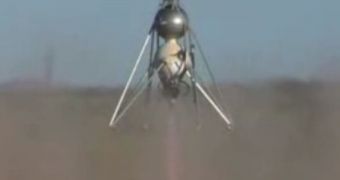Scientists from two teams have until this Saturday, October 31, to prevent the top prize of the Northrop Grumman Lunar Lander Challenge, valued at $1 million, to go to Rockwall, Texas-based Armadillo Aerospace. Throughout this week, the two groups will compete back-to-back, in order to demonstrate that their vehicles are capable of landing and taking off vertically from the hypothetical surface of the Moon, NewScientist reports.
Last October, the Texas company was the first to grab more than $350,000 in award money, as it managed to launch a rocket vertically, at a height of more than 50 meters, and then make it hover for more than 90 seconds, before bringing it down to a smooth landing. The same sequence was then repeated after only a couple of hours, demonstrating the feasibility of its design. The company continued its success row, when it managed to keep its rocket aloft for 180 seconds this September, and then settling it down on a Moon-like terrain filled with boulders. This accomplishment won Armadillo the title of second challenge level winner.
If no other team manages to replicate the Texas company's successes by October 31, then Armadillo will win an additional $1 million, which is the competition's top prize. The Northrop Grumman Lunar Lander Challenge began in 2006, and more than 12 teams registered for participation. By 2008, none of them managed to deliver on their promises and to create spacecraft that would comply with the competition's regulations. Mojave, California-based Masten Space Systems was the only other team to pass the first stage of the Challenge, on October 7. On Wednesday and Thursday, the team will attempt to fulfill the necessary conditions for passing the second stage of the competition.
On Friday and Saturday, another team – Unreasonable Rocket – will attempt to pass both stages of the Challenge. In case both manage to successfully complete the second stage, the top award will be given to the spacecraft that succeeds in landing its space vehicle most accurately. This is a stage in the flight process that would be extremely important in the case of an actual Moon landing. A toppling over, and the mission could be scrubbed for good and all the science equipment lost.

 14 DAY TRIAL //
14 DAY TRIAL //